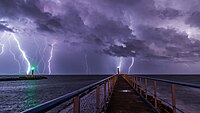
Photo from wikipedia
Predicting the frozen zone near the freezing pipe in artificial ground freezing (AGF) is critical in estimating the efficiency of the AGF technique. However, the complexity and uncertainty of many… Click to show full abstract
Predicting the frozen zone near the freezing pipe in artificial ground freezing (AGF) is critical in estimating the efficiency of the AGF technique. However, the complexity and uncertainty of many factors affecting the ground temperature cause difficulty in developing a reliable physical model for predicting the ground temperature. This study proposed a data-driven framework to accurately predict the ground temperature during the operation of AGF. Random forest (RF) and extreme gradient boosting (XGB) techniques were employed to develop the prediction model using the dataset of a field experiment in the silty deposit. The developed ensemble models showed relatively good performance (R2 > 0.96), yet the XGB model showed higher accuracy than the RF model. In addition, the evaluated mutual information and importance score revealed that the environmental attributes (ambient temperature, surface temperature, humidity, and wind speed) can be critical in predicting ground temperature during the AFG operation. The prediction models presented in this study can be utilized in evaluating freezing efficiency at the range of geotechnical and environmental attributes.
Journal Title: Geomechanics and Engineering
Year Published: 2021
Link to full text (if available)
Share on Social Media: Sign Up to like & get
recommendations!